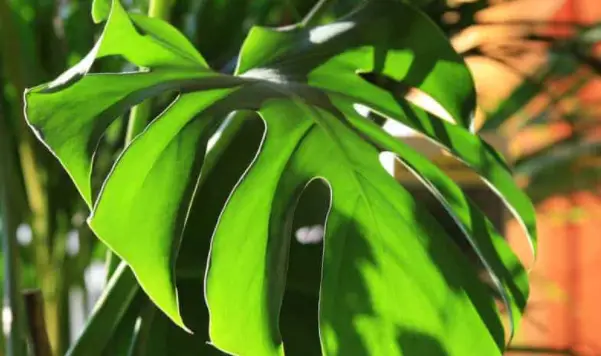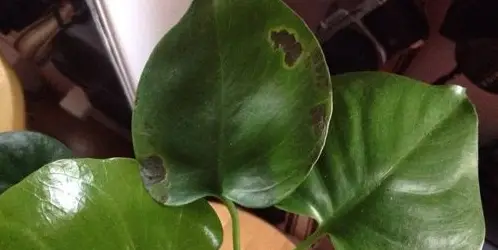The monstera plant is proficient at providing signs when it’s unhappy. One of the most common ways it does this is black spots on the leaves, which could have various causes. Getting to the root cause of these spots will allow you to take the necessary steps to restore the health of your monstera.
Causes of Black Spots on Monstera
Black or brown spots on monstera plants can be easily rectified once the reason is identified. Here are some of the main causes of black spots on monstera:
1) Root Rot
Overwatering your plants has the common side-effect of root rot. These plants do not require as much water as you would imagine and therefore, overwatering them is a common flaw experienced by every plant parent.
Despite this, the monstera is quite durable against these conditions, and a few easy steps can have it on its way back to good health. These include cutting off the dead and dying leaves as well as roots. Remove the plant from its pot with care and gently wash off the soil from its roots.
Once this is done, place the plant in a jar filled with freshwater that is of room temperature. Ensure that only the leaves of the plant are submerged in water and change the water in the jar after a few days regularly. This will effectively remove the black spots from your Monstera.
2) Sunburn
Wild monstera is typically not exposed to direct sunlight in rainforests and is therefore prone to get burnt with ease. This holds especially when you have a variegated Monstera which can develop black spots as a result of overexposure to direct light. View our article on how to make monstera plants grow quicker.
In contrast, the Monstera plant cannot yield big, fenestrated leaves in the absence of light. This conflict can be resolved by placing your plant in a room that is exposed to a sufficient amount of bright and indirect light. Place the monstera plant by the window which is covered by a sheer curtain.
This not only stops the burning, thereby removing the chances of the leaves developing black spots, but it also allows your plant to grow sufficiently without any obstacles. Alternatively, you can attempt to gradually increase the tolerance of your plant to light over time.

3) Dehydration
The monstera plant requires a significant amount of water to sustain itself. Incongruent watering or dehydration can lead to the drying out of the soil, which in turn causes black spots on the leaves of the plant.
This can be rectified by soaking the soil in a few inches of water until you can observe dampness at the top of the soil. In some cases, the soil of the plant may become hydrophobic, thereby dissuading the plant from absorbing any water.
Due to this, soaking the soil in water for a few days will allow rehydration of the plant and provide the soil with the ability to hold water proficiently. Once the roots are encircling the rootball entirely, you can place your monstera plant back into a pot.
4) Physical Damage
Black spots on your monstera leaves can also be caused by touching them during the period of new growth. The delicate and young leaf is more prone to scars with the slightest touch, which can later grow into black spots.
Additionally, if your Monstera plant gets damaged during transit, the black spots probably originated as a result of being packed too tightly or had a leaf bent. These circumstances can cause the leaves to scar with ease, thereby leaving spots.
Young leaves are extremely delicate and can scar easily. Once they grow to their mature size, this scar is shown as a black spot. However, the plant will naturally attempt to heal itself, and you may observe a brown edging on the scar due to this process.
5) Excessive Misting
Most plants do not react well to getting water on their leaves. This essentially causes the leaves to rot, thereby allowing the growth of black spots. Additionally, wet leaves can also be an invitation to bacterial and fungal diseases which can be a source of root rot.
Humidity lower than 40% can lead to misting and therefore black spots on your plant. This can be rectified by purchasing a humidifier that can provide a constant supply of the right amount of humidity to your plants. This, in turn, ensures that the leaves are never exposed to water and prevents rotting.
While monstera plants can grow perfectly well in an environment with 40% humidity, to ensure optimal growth yielding big leaves, a humidity of 65% is required. If you do not want to invest in a humidifier (here’s my favorite on Amazon), keeping your plants in the kitchen will expose them to sufficient humidity.
6) Cold Temperatures
The monstera plant is a tropical plant, and these are known to dislike the cold strongly. As such, you may not want to keep your monstera outside. Cold temperatures are one of the most common causes of black spots. They remain warm during the day; however, when the winter months roll around, they risk dying if it gets too cold at night.
It is possible that the cold weather compromises the immunity of the plant and thereby attracts various fungal diseases. This, in turn, can easily kill the monstera plant, the initial symptoms appearing in the form of black spots.
The solution is to ensure that the plant is kept in a sufficiently warm room, specifically during the cold months. The plant parent should ensure that the leaves are exposed to light whenever possible. You can achieve this by either keeping the room warm or moving your plant to a warmer spot.
7) Disease
As mentioned earlier, black spots on monstera leaves are a result of fungal or bacterial disease. Copper fungicide (Amazon link) is the solution for many. A variety of circumstances can cause this as already listed such as excessive misting, lack of immunity caused by cold temperatures, overwatering of your planets, and so on.
If every other cause behind the black spots is unlikely, a fungal or bacterial disease is the last resort. The only way to rectify this is by cutting off and removing the affected parts of the leaves. This will efficiently remove the fungi or bacteria, causing the disease.
Once the root cause of the black spots is removed, your Monstera plant will recover efficiently on its own. Another cause of the disease could be the prevalence of it in nearby plants to ensure you check those for diseases as well.
Now that we have looked at some of the most prominent reasons for black spots on Monstera leaves let’s explore some ways to prevent the black spots by incorporating general care measures.
General Care Measures
Unfortunately, black spots on your Monstera plants do not become green again. These areas of the leaves can be trimmed if the damage is minimal. However, there are some preventive measures that you can adopt to prevent black spots altogether.
- Expose the plant to bright, indirect sunlight
- Water the plant once every week
- Keep the plant at a temperature range of 65 to 85 degrees Fahrenheit
- Provide sufficient humidity
Verdict
Black bacterial spots on your monstera plant can be dealt with efficiently. If these starts to appear, all you need to do is take some precautionary measures and rectify the source of the problem. I like using Copper fungicide (Amazon link). Once this is done, your Monstera plant is on its way to thriving without a problem.
